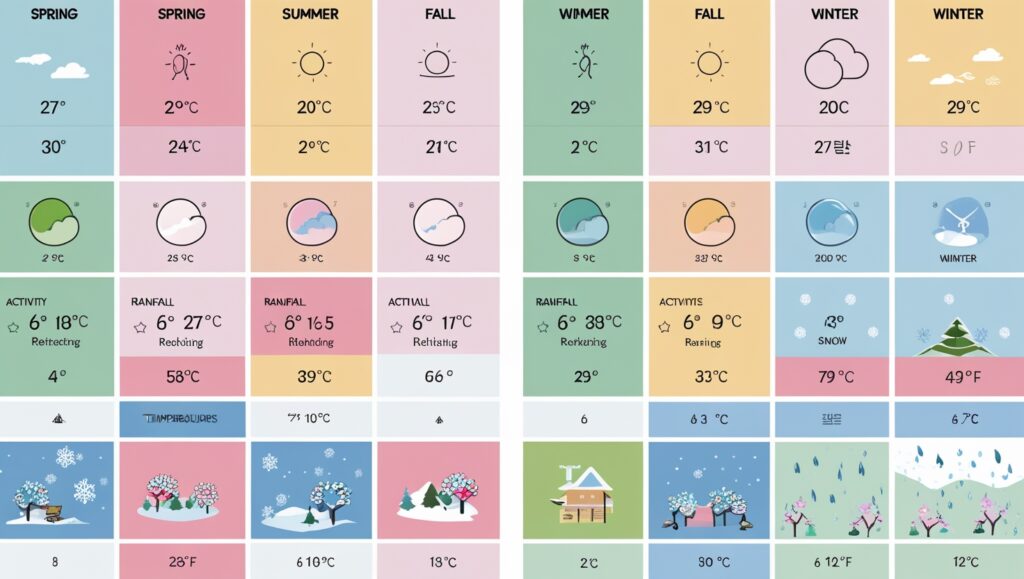Seoul, the dynamic capital of Korea, is a city that combines history, technology and natural beauty. However, if you are planning a visit or travel, understanding of Seoul is very important for optimal use of the experience. From winter to summer, Seoul’s climate is as diverse as its neighbourhoods.
This complete guide explores the weather in Seoul for all four seasons, all four seasons, what to expect, what to pack, and how to enjoy it all year round.
Overview of Seoul Weather
Seoul has a humid continental climate with four distinct seasons. The Seoul weather experience can be both rewarding and challenging, depending on the time of year.
Key Features of Seoul’s Climate:
- Cold winters with occasional snow
- Hot, humid summers with monsoon rains
- Pleasant springs and colorful autumns
- Wide annual temperature range (from -10°C to 35°C)
Let’s dive deeper into each season to better understand how Seoul’s weather shifts throughout the year.
Seoul Weather by Season
Spring in Seoul (March–May)
Spring is one of the most beautiful and comfortable seasons in Seoul. As the city shakes off winter’s chill, cherry blossoms bloom, and temperatures become mild.
Average Temperature:
- March: 2°C to 12°C
- April: 8°C to 19°C
- May: 13°C to 24°C
Weather Characteristics:
- Dry and sunny
- Blooming flowers, especially cherry blossoms
- Increasingly warmer days
Top Things to Do:
- Visit Yeouido for the Cherry Blossom Festival
- Hike in Bukhansan National Park
- Explore traditional palaces in pleasant weather
What to Pack:
- Light jacket or trench coat
- Comfortable walking shoes
- Allergy medication (for pollen-sensitive travelers)
Summer in Seoul (June–August)
Summer brings intense Seoul weather characterized by heat and humidity. It’s also monsoon season, which means frequent, heavy rainfall.
Average Temperature:
- June: 18°C to 28°C
- July: 22°C to 30°C
- August: 23°C to 31°C
Weather Characteristics:
- Hot and humid
- Monsoon rains (jangma) mostly in July
- Occasional typhoons
Top Things to Do:
- Visit indoor attractions like COEX Mall or Lotte World
- Take a cruise along the Han River
- Enjoy summer street food markets
What to Pack:
- Umbrella or raincoat
- Breathable, quick-dry clothing
- Sunscreen and a portable fan
Autumn in Seoul (September–November)
Many consider autumn the best time to visit due to the mild temperatures and stunning fall foliage.
Average Temperature:
- September: 17°C to 26°C
- October: 10°C to 20°C
- November: 3°C to 12°C
Weather Characteristics:
- Crisp, cool air
- Clear skies and low humidity
- Vibrant foliage in parks and mountains
Top Things to Do:
- Take a fall foliage trip to Nami Island
- Enjoy outdoor cafes and street performances
- Walk along the Cheonggyecheon Stream
What to Pack:
- Light sweater or fleece
- Layered clothing
- Camera for capturing fall colors

Winter in Seoul (December–February)
Seoul winters are cold, with temperatures often dropping below freezing. Snowfall is common, although not heavy.
Average Temperature:
- December: -5°C to 4°C
- January: -7°C to 2°C
- February: -4°C to 5°C
Weather Characteristics:
- Dry and cold
- Occasional snow
- Clear skies
Top Things to Do:
- Visit ski resorts near Seoul (like Vivaldi Park)
- Experience Korean jjimjilbangs (saunas)
- Celebrate Lunar New Year festivals
What to Pack:
- Heavy coat, gloves, hat, and scarf
- Heat packs
- Insulated shoes or boots
Monthly Seoul Weather Averages
Here’s a handy table to visualize Seoul’s weather by month:
| Month | Avg High (°C) | Avg Low (°C) | Precipitation (mm) |
| January | 1 | -7 | 21 |
| February | 4 | -4 | 25 |
| March | 10 | 1 | 45 |
| April | 17 | 7 | 78 |
| May | 23 | 13 | 102 |
| June | 27 | 18 | 133 |
| July | 29 | 22 | 350 |
| August | 30 | 23 | 364 |
| September | 26 | 17 | 169 |
| October | 20 | 10 | 52 |
| November | 12 | 3 | 53 |
| December | 3 | -4 | 23 |
How to Prepare for Seoul’s Climate
Tips for Tourists and Expats:
- Check the forecast daily. Seoul’s weather can change quickly, especially during summer.
- Use Korean weather apps like Korea Meteorological Administration (KMA) or Naver Weather.
- Dress in layers during spring and autumn.
- Stay hydrated and take breaks during the summer months.
- Plan indoor and outdoor activities based on seasonal trends.
Best Time to Visit Seoul Based on Weather
If your travel is flexible and based solely on Seoul weather, consider the following:
Ideal Seasons:
- Spring (April–May): Perfect for sightseeing and cherry blossoms.
- Autumn (October–November): Crisp air and stunning fall foliage.
Avoid If You Dislike:
- Extreme heat/humidity: July and August
- Cold weather: December through February
Weather Apps & Tools for Real-Time Seoul Forecast
To stay up to date with the latest Seoul weather reports, these apps and sites are useful:
- KMA (Korea Meteorological Administration): Korea’s official weather body
- AccuWeather: Offers hourly and 15-day forecasts
- Naver Weather: Widely used by locals
- Windy: For advanced weather visualizations and air quality
Final Thoughts on Seoul Weather
Seoul is a city of vibrant contrast—not just in culture, but in climate. From snow-dusted palaces in winter to cherry blossoms by the Han River in spring, each season in Seoul offers its magic.
Understanding Seoul’s weather helps you:
- Plan better itineraries
- Pack more efficiently
- Enjoy local events and experiences comfortably
Whether you’re moving to Seoul, traveling for the first time, or just curious about the climate, remember: the weather is just one of many fascinating layers in Korea’s capital.
Frequently Asked Questions (FAQs)
Q: Is Seoul very cold in winter?
A: Yes, Seoul winters are cold and dry, often with temperatures below freezing.
Q: When is the rainy season in Seoul?
A: The monsoon season, known as “jangma,” usually occurs in July, bringing heavy rainfall.
Q: What’s the hottest month in Seoul?
A: August is typically the hottest, with high humidity and temperatures reaching up to 35°C.
Q: How bad is Seoul’s air pollution?
A: It varies by season, with spring sometimes bringing yellow dust. Check real-time air quality apps.
Q: Can I see snow in Seoul?
A: Yes, snowfall is common in December and January, though it may not accumulate heavily in the city.
